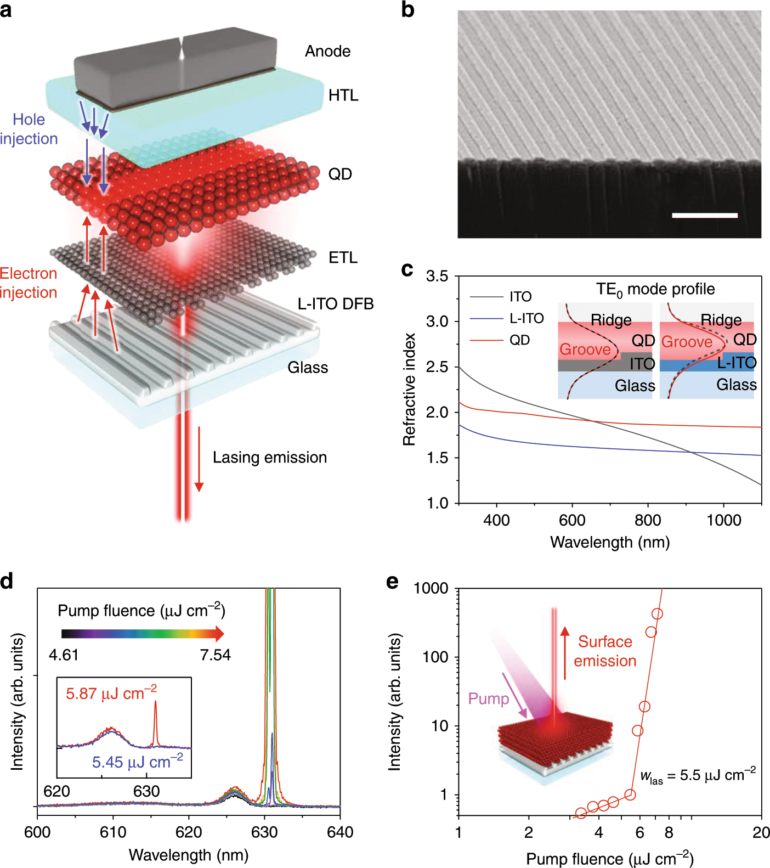A Los Alamos National Laboratory team has overcome key challenges toward technologically viable high-intensity light emitters based on colloidal quantum dot technology, resulting in dual-function devices that operate as both an optically excited laser and a high-brightness electrically driven light-emitting diode (LED).
As described in the journal Advanced Materials, this advance represents a key milestone towards an electrically pumped colloidal quantum dot laser or a laser diode, a new type of devices whose impact would span numerous technologies including integrated electronics and photonics, optical interconnects, lab-on-a-chip platforms, wearable devices and medical diagnostics.
“A quest for colloidal quantum dot laser diodes represents part of a worldwide effort aimed at realizing electrically pumped lasers and amplifiers based on solution-processable materials,” said Victor Klimov, a scientist in Los Alamos’s Chemistry division and the team leader on the research. “These devices have been pursued for their compatibility with virtually any substrate, scalability and ease of integration with on-chip electronics and photonics including traditional silicon-based circuits.”
As in a standard LED, in the team’s new devices, the quantum dot layer acted as an electrically actuated light emitter. However, due to extremely high current densities of more than 500 ampere per square centimeter, the devices demonstrated unprecedented levels of brightness of more than a million candela per square meter (candela measures luminous power emitted in a given direction). This brightness makes them well-suited for applications such as daylight displays, projectors and traffic lights.
The quantum dot layer also behaved as an efficient waveguide amplifier with large net optical gain. The Los Alamos team achieved narrow-band lasing with a fully functional LED-type device stack containing all charge transport layers and other elements required for electrical pumping. This advance opens the door to the highly anticipated demonstration of lasing with electrical pumping, the effect which will allow for full realization of the colloidal quantum dot lasing technology,.
Colloidal quantum dots
Semiconductor nanocrystals—or colloidal quantum dots—are attractive materials for implementing lasing devices, including laser diodes. They can be prepared with atomic precision via moderate-temperature chemical techniques.
Additionally, because of their small dimensions, comparable to a natural extent of electronic wave functions, quantum dots exhibit discrete atomic-like electronic states whose energies directly depend on particle size. This consequence of a so-called “quantum-size” effect can be exploited to tune the lasing line to a desired wavelength or to design a multi-color gain medium that supports lasing at multiple wavelengths. Additional advantages derived from a peculiar atomic-like spectrum of quantum dot electronic states include low optical gain thresholds and suppressed sensitivity of lasing characteristics to changes in device temperature.
Innovation design for solving electrical pumping challenges
Most quantum dot lasing research has employed short optical pulses for exciting an optical gain medium. The realization of lasing with electrically driven quantum dots is a much more challenging task. With their new devices, the Los Alamos research team made an important step toward this objective.
“One challenge lies in the area of electrical and optical device designs,” said Namyoung Ahn, a Laboratory director’s postdoctoral fellow and a lead device expert on the quantum dot team. “In particular, the device’s charge injection architecture must be capable of generating and sustaining very high current densities required for laser action. The same device must also exhibit low optical losses so as not to suppress gain generated in a thin quantum dot active medium.”
To boost optical gain, the team developed new nanocrystals that they dubbed “compact compositionally graded quantum dots.”
“These novel quantum dots feature suppressed Auger recombination due to a built-in compositional gradient and simultaneously exhibit a large gain coefficient when assembled in a close-packed solid used as an optical gain medium,” said Clément Livache, a postdoc on the quantum dot team who performed spectroscopic studies of the fabricated devices. “This helps realize net optical gain in a complex electroluminescent structure wherein a thin, light-amplifying quantum dot layer is combined with multiple light-absorbing charge-conducting layers.”
To facilitate light amplification, the researchers also reduced optical losses in their devices. In particular, they re-designed the charge injection architecture by removing optically lossy metal-like materials and replacing them with properly optimized low-absorptivity organic layers. In addition, they engineered a device cross-section profile so as to reduce the optical field intensity in highly absorptive charge transport layers and simultaneously to enhance it in the quantum dot gain medium.
Finally, to enable laser oscillations, the developed devices were supplemented by an optical cavity prepared as a periodic grating that was integrated into one of the device electrodes. This grating acted as a so-called distributed feedback resonator that allowed for circulating light in the lateral plane of the quantum dot layer, allowing for multi-pass amplification.
The final challenge
The lasing effect was attained employing optical excitation. Lasing using electrical pumping was not observed because of degradation of device performance caused by excessive heat generated by a passing current. This is the final challenge that needs to be addressed to demonstrate electrically driven laser oscillations.
Just a few years ago, electrically pumped colloidal quantum dot lasers were widely deemed impossible due to problems such as ultrafast Auger decay, insufficient current densities in quantum dot LEDs, and difficulties in combining electroluminescent and lasing functions in the same device. The Los Alamos quantum dot team’s results demonstrate practical solutions to most of these problems, suggesting that a functional quantum dot laser diode is close at hand.
More information:
Namyoung Ahn et al, Optically Excited Lasing in a Cavity‐Based, High‐Current‐Density Quantum Dot Electroluminescent Device, Advanced Materials (2022). DOI: 10.1002/adma.202206613
Provided by
Los Alamos National Laboratory
Citation:
Engineers develop dual-purpose laser and LED device based on colloidal quantum dot technology (2023, March 27)


